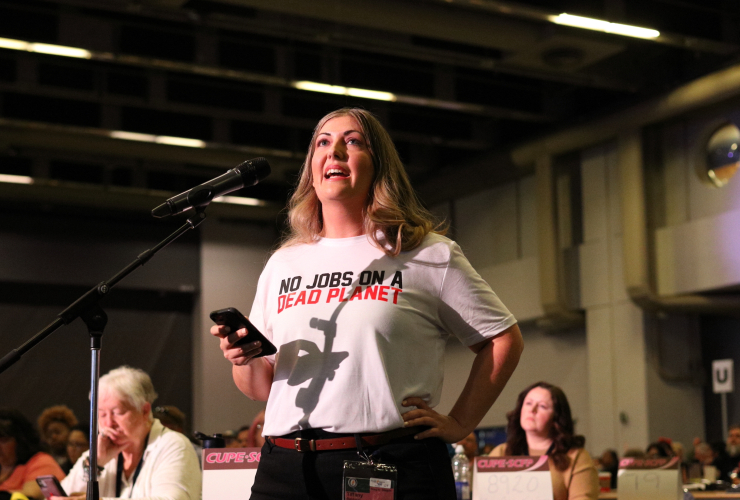Climate action and clean growth in Canada could create hundreds of thousands of new jobs in sectors across the country. Yet, to realize these benefits, regions across Canada will need to put the right supports and planning in place to support companies and workers.
On June 15, the federal government released Bill C-50, outlining the approach the country intends to take to support sustainable jobs. This approach is a good start, but it does not tackle the thorniest questions in the green jobs debate.
Let’s start with what the approach gets it right. Bringing in representation from across regions and sectors to advise on sustainable jobs is a smart move. Ensuring planning for skills needs is based around existing programs, like tax incentives and spending, is also a win-win.
And working closely with the Regional Energy and Resource Tables is a great way to ensure provinces prioritize training programs based on the opportunities they seek to advance.
However, the plan falls short in ways that will need to be addressed in future iterations. Many of its shortcomings arise from failing to acknowledge that climate action will lead to more jobs for Canadians overall, but not in every sector, and job growth and declines may not always occur in the same geographic locations. Saskatchewan, for example, could see tens of thousands of new roles created in construction, food manufacturing and carbon management. But these jobs are not guaranteed to be within commuting distance of Estevan and Coronach, two communities where workers now employed in coal-fired electricity generation are pondering their futures.
Tackling this problem requires thinking about two questions. First, what opportunities exist for workers in these communities? Second, for regions where clean growth is expected, how can we ensure they have enough skilled workers needed to fill emerging roles?
For the first question, the answers need not be green. Policymakers have a tendency to presume that the best substitute for a job in an emissions-intensive energy sector is a job in the clean energy sector. Yet, data show energy sector workers looking for new roles disagree. LinkedIn data from 2020 shows that the top three destinations for displaced oil and gas workers were manufacturing, construction, and software and IT services.
What matters most for workers is not working in the same field, but rather having interesting job opportunities today, within commuting distance, where they can apply their skills. This reality allows policymakers to think beyond the economic perspective of “reallocating laid-off workers from one sector to another” to consider approaches that empower workers and respect their freedom of choice. This means supporting more successful programs like the EDGE UP from Calgary Economic Development, a program that trains energy sector workers for software roles.
The response to the first question complicates answering the second. If workers potentially seeking employment are not in the same regions where sustainable jobs are being created, or are entering other sectors, how will these growing clean industries fill emerging roles? This is arguably Canada’s greatest challenge. There is a risk that climate action and clean growth create more jobs than can be filled by the available workforce.
Our new report from the PLACE Centre, Ready for green jobs, shows that clean growth could create the most jobs in the industries and regions currently facing the highest worker shortfalls. For example, construction could see a jobs boom by 2030, creating between 56,000 and 146,000 jobs. But for a sector already facing a worker shortage of almost 90,000, it’s unclear if there will be enough workers to fill these roles. Upcoming retirements will likely worsen this challenge, with sectors like agriculture and manufacturing set to experience more exits than entries this decade.
(This graph represents the gap between job vacancies in key clean-growth industries across four different future job-growth projections. The vacancies stand in clear contrast to projected job growth, posing a problem for policymakers. Specifically, it may be hard to find workers for these clean-growth jobs when those industries are already experiencing high job vacancy rates. The four categories are representations of the types of global conditions using the measurements of 1) changes in trade co-operation, and 2) disruptions to the global economy from conflict, pandemics, and natural disasters. Sunny is high co-operation and low disruption. Windy is high co-operation and high disruption. Stormy is high disruption and low co-operation. Foggy is low disruption and low co-operation.)

If Canada cannot find enough workers to fill roles, the outcomes could be severe. Projects will take more time to build and costs will increase. Some could even be cancelled outright. If this happens in enough sectors, it puts our ability to grow our economy and meet our climate targets at risk.
The next round of the sustainable jobs plan, set for release in 2025, should plug these gaps. It should distinguish between the two challenges of attracting workers for growing sectors and advancing clean growth opportunities in regions where declines are expected.
The next round should also discuss how housing, public transit infrastructure, and settlement and integration supports will be offered for growing hubs of sustainable jobs like Portage la Prairie, Man. or St. Thomas, Ont.
Canada’s sustainable jobs legislation is a step in the right direction. But more is needed to tackle the workforce challenges climate action and clean growth will bring.
By reckoning with the challenges outlined here, the planned update in 2025 can play a more meaningful role in supporting workers in Canada’s growing clean economy.
John McNally is the director for clean and resilient growth at the PLACE Centre, an initiative of the Smart Prosperity Institute. Nicholas Renzetti is a research associate at PLACE. The PLACE Centre is a research initiative aimed at advancing place-based solutions to create livable and affordable communities, and advancing economic growth while reducing emissions and adapting to a changing climate. PLACE has partnered with Future Skills Centre on a multi-year project studying green jobs and skills needs for different regions and opportunities across Canada.
It's a bit bizarre to
It's a bit bizarre to consider forestry and agriculture together as one area of economic enterprise.
And the "sunny, windy, stormy, foggy" designations need some explanation. Without that, the chart only shows a negative shortage of workers, i.e., an excess, by 2030.
As for "LinkedIn data from 2020 shows that the top three destinations for displaced oil and gas workers were manufacturing, construction, and software and IT services," of course those paid high wages want to relocate to sectors notable for high wages.







Comments